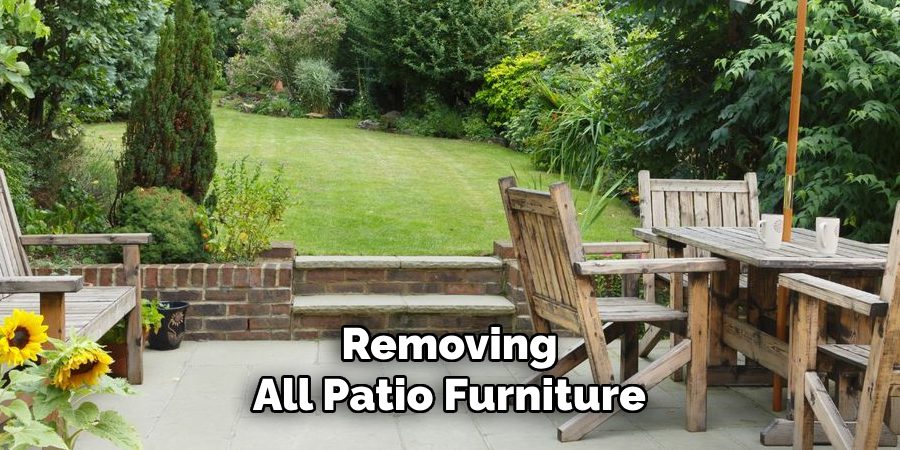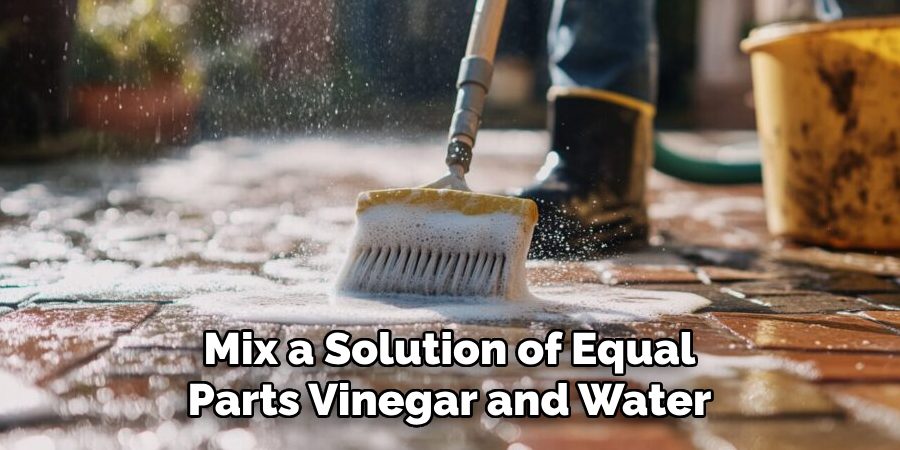A clean patio is essential for creating an inviting and functional outdoor space, perfect for gatherings, relaxation, or enjoying nature. However, not everyone has access to a pressure washer, a commonly used tool for patio cleaning. Fortunately, learning how to clean patio without pressure washer can present a range of advantages. This method is more affordable, eliminating the need for expensive equipment.

It’s also eco-friendly, often relying on natural solutions and less water consumption than pressure washing. Additionally, it safeguards delicate materials like wood or fragile stone from potential damage caused by high-pressure water. This guide provides you with simple, step-by-step methods to achieve a spotless patio using alternative tools and techniques. With a little effort and regular upkeep, you can maintain your patio’s appearance and longevity without needing specialized machinery.
Tools and Materials Needed
The right tools and materials are essential for effectively cleaning your patio without a pressure washer. Below is a list of recommended items to ensure a thorough and hassle-free cleaning process.
Basic Cleaning Tools
To get started, you’ll need a selection of basic cleaning tools, such as a stiff-bristle brush to tackle tough stains and dirt. A broom will be useful for sweeping away loose debris, while a mop can apply cleaning solutions to larger surfaces. Scrubbing pads are another versatile tool ideal for smaller, targeted areas that require extra attention.
Cleaning Solutions
Various cleaning solutions can be used based on personal preference and the material of your patio. Dish soap is a universally effective choice for mild cleaning while baking soda provides a gentle abrasive action for tougher grime. White vinegar is an excellent natural option for tackling algae or mold, and oxygen bleach works well for brightening surfaces. You may also opt for a commercial patio cleaner for a more specialized approach.
Water Sources
A garden hose with a spray nozzle is a convenient water source for rinsing and wetting your patio. Alternatively, a simple bucket of water will suffice if a hose is unavailable.
Optional Equipment
For increased convenience, consider using a deck brush with a long handle. This tool makes scrubbing larger areas easier and reduces the strain on your back during cleaning.
Preparing the Patio for Cleaning
Step 1: Clearing the Area

Before you begin cleaning, removing all patio furniture, planters, and decorative items is essential to allow for an unobstructed cleaning process. This ensures that no areas are missed and helps prevent potential damage to your belongings. Once the patio is cleared, use a stiff broom to sweep away loose dirt, leaves, and other debris. This step is crucial for preparing a clean surface, making the upcoming washing process more efficient.
Step 2: Checking for Stains and Mold
Carefully inspect the patio for any deep stains, moss, or mildew buildup. Identifying these problem areas early allows you to choose the best approach for treatment. For example, deep oil or grease stains may require a degreaser. At the same time, areas affected by moss or mildew can benefit from natural solutions like white vinegar or stronger cleaning agents such as oxygen bleach. Understanding the type of stains present will simplify the cleaning process and ensure more targeted results, leaving your patio looking its best.
How to Clean Patio Without Pressure Washer: Choosing the Best Cleaning Method
When cleaning your patio, selecting the right method is vital for achieving the best results. Different cleaning methods are suitable for various dirt, stains, and buildup levels. Below are four tried-and-tested methods, each tailored to target specific cleaning needs:
Method 1: Soap and Water (Best for Light Cleaning)
Mixing warm water with dish soap in a bucket is an effective and gentle solution for routine maintenance or lightly soiled patios. Use a mop or scrubbing brush to apply the soapy water and scrub the surface. Once finished, rinse thoroughly with clean water to remove any residue.

Method 2: Vinegar and Baking Soda (Best for Removing Grime and Mildew)
This natural and environmentally friendly solution works wonders for removing grime and mildew. Sprinkle baking soda over the stained areas, then spray white vinegar on top, allowing it to fizz for a few minutes. Scrub the area with a stiff brush to lift the buildup, and rinse with clean water for a fresh finish.
Method 3: Oxygen Bleach Solution (Best for Deep Cleaning)
An oxygen bleach solution can be a powerful ally for more stubborn dirt and stains. Prepare the solution by mixing oxygen bleach with water per the product instructions. Pour it over the patio and allow it to sit for 10–15 minutes. Scrub thoroughly with a durable brush, and then rinse the area well to reveal a clean surface.
Method 4: Commercial Patio Cleaners (For Tough Stains and Moss)
When facing tough stains or moss growth, using a commercial patio cleaner may be the best action. Choose an eco-friendly cleaner suitable for your patio’s material to avoid damage. Follow the manufacturer’s instructions for correct application, scrubbing, and rinsing for optimal results.
Scrubbing and Rinsing the Patio
Step 1: Applying the Cleaning Solution
Begin by pouring or spraying your chosen cleaning solution over the patio surface. Whether you’ve opted for a homemade mixture, an oxygen bleach solution, or a commercial cleaner, ensure the solution is evenly distributed across the area. Allow it to sit for a few minutes, as this will help loosen dirt, grime, and stains, making them easier to remove during scrubbing. Be sure to follow the recommended sitting time for your specific cleaning product to avoid damage to the patio material.

Step 2: Scrubbing the Surface
After letting the solution work its magic, it’s time to scrub the patio. Using a stiff-bristle brush, focus on scrubbing any stubborn stains, moss patches, or heavily soiled areas, such as high-traffic patio sections. Break the task into manageable sections for larger patios to ensure thorough and even cleaning. Apply consistent pressure while scrubbing, but be mindful of the patio material to avoid scratching or damaging the surface.
Step 3: Rinsing with Water
Once scrubbing is complete, rinse the patio thoroughly with clean water. Use a garden hose for even coverage or buckets of water if a hose is unavailable. Make sure to remove all the cleaning solution and loosened dirt. Leaving soap residue behind can create slippery spots or attract more dirt over time. A well-rinsed patio looks fresh, is safe for walking, and is ready for furniture or decoration placement.
Spot Cleaning Stains and Mold
Keeping your patio spotless often requires addressing specific stains and mold that don’t come off during general cleaning. Here’s how to handle common trouble spots:
Oil and Grease Stains
For oil or grease marks, sprinkle a generous amount of baking soda directly on the stain. Allow it to sit for about 10 minutes to absorb the oils. Then, scrub the area with a brush using warm, soapy water. Rinse thoroughly to lift the residue and restore the patio surface.
Moss and Algae
Mix a solution of equal parts vinegar and water to remove moss and algae. Apply the mixture directly to the affected areas and allow it to sit for a few minutes. Scrub the spots using a stiff-bristle brush until the moss and algae are dislodged. Finish by rinsing the area with clean water.

Rust Stains
Lemon juice and salt are effective natural treatments for rust stains. Sprinkle salt over the stain and pour lemon juice over it until fully saturated. Allow the mixture to sit for 10 minutes, giving it time to break down the rust. Scrub the area gently and rinse thoroughly to reveal a clean surface.
Addressing these problem areas regularly will maintain your patio’s appearance and extend its lifespan.
Drying and Maintaining the Patio
Letting the Patio Air Dry
After cleaning, allowing the patio to air dry completely before use is crucial. Avoid walking on the wet surface, as this can leave footprints or disturb the cleaned area, reducing the effectiveness of your efforts. Depending on weather conditions, drying may take a few hours to an entire day. Sunshine and a mild breeze will accelerate the drying process. Ensuring the patio is fully dry also minimizes the risk of slips and falls.
Regular Maintenance Tips
Maintaining your patio regularly will preserve its appearance and prevent the need for frequent deep cleaning. Make it a habit to sweep the patio at least once a week to remove dust, dirt, and debris. This simple step reduces the accumulation of materials that can cause stains or promote moss and algae growth. Act promptly to remove spills; leaving them untreated may result in stubborn marks that are harder to clean later. Additionally, consider applying a sealant to your patio surface. Sealing provides a protective layer against stains, water damage, and weathering, ensuring your patio remains in excellent condition for years to come. With consistent care, you can keep your patio both functional and visually appealing.
Common Mistakes to Avoid
Using Harsh Chemicals
One common mistake is using harsh chemicals to clean your patio. These substances can damage sensitive patio materials such as natural stone or concrete and may even harm nearby plants or grass. Instead, opt for cleaners specifically designed for patio surfaces or use homemade solutions like mild soap and water to avoid unnecessary damage.
Not Rinsing Thoroughly
Failing to rinse your patio thoroughly after cleaning can leave behind slippery residue, which poses a safety hazard. Detergents or cleaning agents that are not washed off properly can also attract more dirt over time, undoing your cleaning efforts. Always ensure to rinse your patio well with clean water.

Skipping Regular Maintenance
Neglecting regular maintenance can make future cleanings far more challenging. Dirt, debris, and stains accumulate over time, becoming harder to remove. By sticking to a routine of sweeping and spot-cleaning, you can prevent larger, more time-consuming problems later.
Conclusion
Learning how to clean patio without pressure washer involves adopting simple yet effective methods to keep your outdoor space spotless. Start by choosing the right cleaning solution tailored to the type of dirt and stains you’re tackling—mild soap and water work well for most patios. Always rinse thoroughly to prevent residue buildup and ensure safety. Regular sweeping and spot cleaning are crucial to avoid dirt accumulation and maintain a welcoming patio. By implementing these strategies, you can preserve the beauty of your patio and enjoy a clean, safe environment without the need for heavy equipment.

Professional Focus
Oliver Wood, a passionate patio designer, specializes in creating comfortable and inviting outdoor spaces that enhance relaxation and entertainment. His work combines a deep understanding of design with a love for nature, making him a standout professional in the field of outdoor living spaces. Through his thoughtful approach, he transforms everyday patios into extraordinary retreats for family and friends.
About the Author
Oliver Wood, a skilled patio designer, shares his expertise on outdoor living through his designs and insights. With a background in patio design and a genuine passion for creating beautiful spaces, he encourages others to invest in their outdoor environments, enhancing their homes with functional and inviting spaces for relaxation and entertainment.
Education History
University: Virginia Union University
Oliver’s education equipped him with the knowledge and skills to design patios that merge aesthetics with comfort, transforming outdoor areas into beautiful extensions of the home.
Expertise:
- Patio Design and Outdoor Living Spaces
- Functional and Aesthetic Landscaping
- Comfortable and Inviting Outdoor Environments
- Design Philosophy for Family-Oriented Spaces
- Creating Spaces for Relaxation and Entertainment
